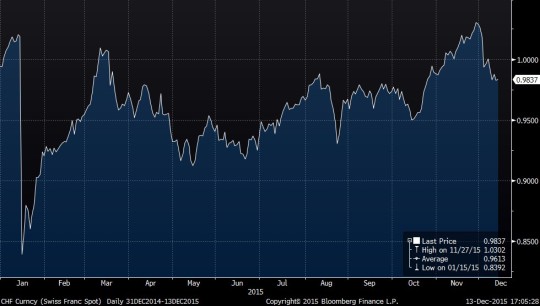
Arguably, the three biggest Central Bank (“CB”) driven surprises so far this year:
The three events listed above were particularly educational for me, as each CB action and marketresponse had its own unique impact on the portfolio given three different positioning environments:
- SNB – No significant CHF positioning into the moveo
- PBoC – Large, specific CNH positioning in anticipation of the move
- ECB – Large portfolio positions and substantial risk exposure
The market shocks I observed and their corresponding impact on my portfolio all rang strong truth towhat I have discussed in detail in Chapter 10, “Portfolio Paralysis”, of my book, The Next Perfect Trade:
Huge optionality lies in having unencumbered capital.
I have described Portfolio Paralysis as the instance when you cannot take advantage of a sudden market dislocation because your capital is already tied up in existing positions.
Aware of my previous tendencies to be overconfident and stretch positions enough to become vulnerable to portfolio paralysis, I had introduced a discipline of limiting exposure during the “good times”, when everything seems to be going my way. Hence when the market suddenly turns I can take advantage of the dislocation and increase positions, rather than being forced to cut.
My long bonds, long dollar, long stocks portfolio had been tremendously productive through 2014 and into the first quarter of 2015. Correspondingly, I exercised some caution proceeding further into the year. Retrospectively, it was still not enough caution.
One could make an argument that I was sized correctly because I survived the vicious correction in the second quarter and was even able to incrementally add risk. Yet by June 2015, the drawdown put me uncomfortably close to the edge of the cliff. In action movies, heroes repeatedly dodge bullets or cars by a millimeter, narrowly slip under the drop-down gates or deftly defuse bombs with only seconds remaining. I posit that in markets, as in real-life action sequences, such circumstances are a sign of failure to be in the position in the first place rather than success in getting out. In other words, if you teeter too often on the edge – you are bound to fall off sooner or later.
How does this lesson relate to the three central bank surprises?
Going into the ECB meeting, I considered myself not to be overextended. Having said that, an important tenet of my strategy is not to reduce my core positions ahead of important data releases or policy meetings. My rationale is that if markets were to gap in my favor, I would irrevocably lose a portion of my profits. Alternatively, if the markets were to gap against me, I would still expect to recover the money given that my long-term view is likely to be correct.
So, I took some profits on the favorable Euro move in November 2015 and was not losing any sleep over the ECB. The result, however, is self-evident: EVERY position in the portfolio was hit, causing a multi-standard deviation loss (not that I believe in the Bell Curve probabilities). December 3rd turned out to be the single worst trading day of my career in percentage terms. Yet, it was nowhere near the most painful or stressful day.
In fact, I started the day at an all-time High-Water Mark with a decent amount of profits locked up. While the move was ferocious in total drawdown terms, my portfolio was under much less pressure than during the second quarter compression and other tough spots in my career. I was able to judge this time that the ECB-related contagion and sell-off in the US Treasury Bonds was largely position driven and likely to be short-lived. I not only held on to all my positions, but also was marginally able to increase my long bonds exposure. Even so, it felt and still feels a little too close for comfort. Importantly, caution precluded me from SIGNIFICANT increase in positions, and therefore, I didn’t really take advantage of the volatility.
Now, I am not so arrogant to believe that I should make money on every instance of a violent market move. All you can hope for as an experienced trader is that the aggregate of your first buy/sell reactions puts you slightly ahead of the game over your career. A long-term trader faces a tradeoff: keep your position larger to profit more on the underlying trend and risk portfolio paralysis OR decrease risk size to have “dry powder” when the market dislocates.
There is no exact criterion for the right level of risk. But consider this: I was spot on with China,anticipating both the equities sell-off and the currency devaluation. Fearing a short-squeeze, I expressed my views via options with the intention to hold them into expiration. But options entail additional risks of failure discussed in Chapter 9, “Adding Unnecessary Complexity”, of The Next Perfect Trade. As Chinese markets were recently progressing in my direction, I explained in my October 5th blogpost, complete success was far from certain. Indeed, due to imperfect timing and time decay on the options I have only managed to break-even on the equity trades. The currency options are deep in the black, but as I have written, the battle is far from over.
Finally, the CHF de-pegging in January caught me completely by surprise. In fact, in December 2014 I wrote about initiating a short CHFMXN position. However, my exposure to CHF had been sufficiently small and overall performance sufficiently good, that on January 15th, I experienced no hint of portfolio paralysis. I was able to think clearly and take advantage of the panic by selling CHF. This is what I wrote on that day. By diving into the unexpected dislocation, the trade turned out to be one of my best money-makers, both in absolute terms and in terms of the ROC in 2015.

Hence, the lesson of 2015 taught by Central Banks:
During extreme market events, a clear head and free capital may often trump correct, but unwieldy positioning.
Good Luck with the Fed this week.
Image: A New Japanese 7th Grade Classroom by Angie Harms


